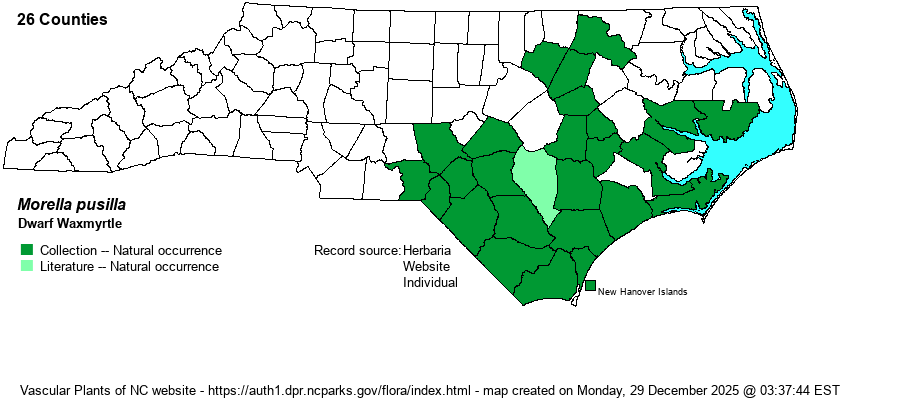| Author | (Raf.) Weakley & D.B. Poind. | |
| Distribution | Strictly in the Coastal Plain, where it seems to be present over most of the province. The exact range is not known completely, as this is a recent split. It does not occur in the adjacent Piedmont, as far as known. It may well be absent also from some northern counties in the Coastal Plain.
As expected, this is a Coastal Plain species, ranging from southeastern VA south to FL, and west to LA if not also to eastern TX. Exact details of the range are not well known.
| |
| Abundance | Reasonably common to locally abundant, as this is a clonal/stoloniferous species. Certainly it is scarce in a few areas of the Coastal Plain, especially in the northern portions, but in the southern half it is often easily found. | |
| Habitat | This is a species of mesic pinelands, for the most part. It grows in pine flatwoods, drier parts of pine savannas, and in pine/scrub oak sandhills. It also can grow well in Mainland Maritime Forest sites, and sparingly in xeric sandhills with Turkey Oak (Quercus laevis). It often does well in the long absence of fire, but as it is stoloniferous and low-growing, it presumably is favored by frequent fire. | |
| Phenology | Flowers in April; fruits from August to October. | |
| Identification | This is a low-growing evergreen shrub that often forms extensive colonies. It grows mostly just 1-2 feet tall, but plants often are touching others of the same species, in sizable stands. The leaves are alternate, narrowly oblanceolate and toothed at the tips; however, they grow only to about 1-1.5 inches long. Though Common Waxmyrtle (M. cerifera) often grows close to it, or with it, the two are easily separated by leaf size and colonial nature of this species. (Seedling Common Waxmyrtles should have leaves reaching to 3 inches long.) Also, flowers or fruit on a waxmyrtle only 1-2 feet tall will certainly be this species. Weakley (2018) mentions that this species has a peak flowering period three weeks later than M. cerifera. | |
| Taxonomic Comments | Weakley and Poindexter, in a 2023 issue of Journal of the Botanical Research Institute of Texas, argue that the oldest valid species name is pusilla, not pumila. Most references do not recognize either name as a valid species and lump it within M. cerifera; however, Weakley (2018) does, as does this website. Weakley and Poindexter give a number of reasons for elevating it to species status. In fact, most veteran NC field biologists who are familiar with both forms likely would consider each as valid species. At least, RAB (1968) recognized the differences, and named this taxon as a separate variety – var. pumila. In fact, the RAB map shows records for over half of the Coastal Plain counties, ranging to the VA line, whereas the BONAP map is woefully incomplete.
| |
| Other Common Name(s) | Dwarf Bayberry | |
| State Rank | [S4] | |
| Global Rank | GNA | |
| State Status | | |
| US Status | | |
| USACE-agcp | | |
| USACE-emp | | |

